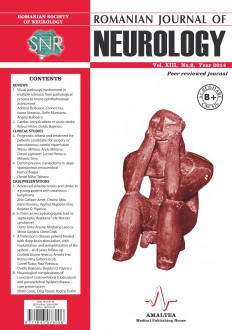SELECT ISSUE

Indexed

| |

|
|
|
| |
|
|
|

|
|
|
|
|
|
| |
|
|
HIGHLIGHTS
National Awards “Science and Research”
NEW! RJN has announced the annually National Award for "Science and Research" for the best scientific articles published throughout the year in the official journal.
Read the Recommendations for the Conduct, Reporting, Editing, and Publication of Scholarly work in Medical Journals.
The published medical research literature is a global public good. Medical journal editors have a social responsibility to promote global health by publishing, whenever possible, research that furthers health worldwide.
PROGNOSTIC CRITERIA AND TREATMENT FOR PATIENTS CANDIDATES FOR SURGERY OR PERCUTANEOUS CAROTID REPERFUSION
Marius Militaru, Anda Militaru, Daniel LIGHEZAN, Lucian Petrescu and Mihaela Simu
ABSTRACT
Background. Atherosclerosis is a systemic disease involved in cerebrovascular disease (CVD), coronary arterial disease (CAD), and peripheral arterial disease (PAD). Atherosclerotic carotid artery stenosis is an important cause of ischemic stroke, accounting for approximately 20-30% of all ischemic strokes. Carotid endarterectomy (CEA) and Carotid angioplasty stent (CAS) are interventional treatment for symptomatic and asymptomatic patients with severe carotid artery stenosis.
Purpose. The purpose of this study was to evaluate the prognostic and treatment criteria in patients with severe carotid uni/bi-lateral stenosis in different circumstances: symptomatic/asymptomatic, with recent or old ischemic stroke, candidates for (CEA) or stent (CAS), with/without involvement of coronary arteries and peripheral endothelial function.
Material and methods. The study included 85 patients with severe carotid stenosis (over 70%) that have been evaluated for CEA or CAS. Patients were evaluated with Carotid Doppler and/or Angio CT of the cervical region, cardiac ultrasound and cerebral/coronary/peripheral angiography, thus assessing the degree of coronary and peripheral involvement. The following have been calculated: ejection fraction (EF) (%), telediastolic volume (TDV) (ml), overall cardiovascular risk - blood pressure score (Score BP), (ranging 1-4 according to severity) and 2 composite scores: global cardiovascular and hemodynamic risk score (GCVHRS), (ranging 1-10 according to risk factors summation) and organic vascular risk score (OVRS), (ranging 1-10 according to the number and topographic status of stenosis). Patients were divided into four groups: a) with carotid stenosis only (CaAS), b) with CaAS damage and coronary stenosis (CoAS), c) with CaAS damage and peripheral stenosis (PAS) and d) global vascular involvement (CaAS,CoAS,PAS). All study patients were compared with 85 matched patients with cardiovascular risk factors without signs of clinical organ damage.
Results. Among the 85 patients with severe carotid stenosis, 52 (61.2%) patients had ICA stenosis between 90%- 99%, 37 (43.5%) patients had CaAS involvement and 14 (16.5%) patients had multiple organ vascular damage. GCVHRS was significantly higher in the patient group with both CaAS and CoAS (scoring 5.80+/-2.33*) and also OVRS in patients with severe multiple organ vascular involvement (scoring of 6.78+/-1.42*), compared to the other groups of patients (p < 0.05). The hemodynamic risk evaluation in CaAS had a EF mean of 52.27+/-7.56 (%) and a TDV mean of 92.13+/-30.27* (ml) while in the global vascular involvement group EF dropped to a mean of 45.71+/-13.56 (%) and TDV increased to a mean of 124.28+/-51.38 (ml).
Conclusions. Higher composite scores (GCVHRS and OVRS) and decrease of EF best correlated with: the degree of carotid stenosis, with the presence of left internal carotid involvement, with the presence of a contralateral involvement (stenosis/occlusion). Secondary vascular disease prevention is mandatory in patients with carotid, coronary and peripheral arterial disease. A composite vascular risk evaluation is useful for individually tailoring our interventional treatment strategy thus improving the global functional outcome of any given patient.
*P < 0.05
Keywords: carotid artery stenosis > 70%; endarterectomy/stent, ejection fraction, global cardiovascular and hemodynamic risk score, vascular organic risk score
Full text | PDF
